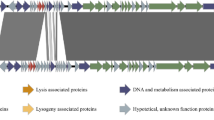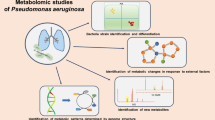Abstract
Six serum-resistant (serR) mutantPseudomonas aeruginosa strains were isolated from six serum-sensitive (serS) parental strains by subculturing the sensitive strains in increasing concentrations of normal pooled fresh human serum (FHS). Although the colonial type of the mutant was similar to that of the parental strains, each of the serR mutants had an altered serotype when compared to its parental counterpart. Three mutant strains and their corresponding parental strains were chosen for further examination. The lipopolysaccharide (LPS) preparations from the serR strains were found to be heterogeneous, containing LPS with varying degrees of O-side-chain substitution, whereas the LPS of the serS strains contained primarily lipid A-core polysaccharide components. Although two of the serR mutant strains had an outer membrane protein (OMP) profile analogous to their serS parental counterparts, one serR strain differed from its parental strain by the absence of a 32,000 dalton major OMP. These studies suggest that the susceptibility ofP. aeruginosa to the bactericidal activity of FHS may be related to either or both LPS structure or OMP content.
Similar content being viewed by others
Literature Cited
Borowski, R. S., Schiller, N. L. 1983. Examination of the bactericidal and opsonic activity of normal human serum for a mucoid and non-mucoid strain ofPseudomonas aeruginosa. Current Microbiology9:25–30.
Chester, I. R., Meadow, P. M., Pitt, T. L. 1973. The relationship between the O-antigenic lipopolysaccharides and serological specificity in strains ofPseudomonas aeruginosa of different O-serotypes. Journal of General Microbiology78:305–318.
Darveau, R. P., Hancock, R. E. W. 1983. Procedure for isolation of bacterial lipopolysaccharides from both smooth and roughPseudomonas aeruginosa andSalmonella typhimurium strains. Journal of Bacteriology155:831–838.
Feingold, D. S. 1969. The serum bactericidal reaction. IV. Phenotypic conversion ofEscherichia coli from serum-resistance to serum-sensitivity by diphenylamine. Journal of Infectious Diseases120:437–444.
Goldman, R. C., Leive, L. 1980. Heterogeneity of antigenic-side-chain length in lipopolysaccharide fromEscherichia coli O111 andSalmonella typhimurium LT2. European Journal of Biochemistry107:145–153.
Hildebrandt, J. F., Mayer, L. W., Wang, S. P., Buchanan, T. M. 1978.Neisseria gonorrhoeae acquire a new principle outer-membrane protein when transformed to resistance to serum bactericidal activity. Infection and Immunity20:267–273.
Hitchcock, P. J., Brown, T. M. 1983. Morphological heterogeneity amongSalmonella lipopolysaccharide chemotypes in silver-stained polyacrylamide gels. Journal of Bacteriology154:269–277.
Hoiby, N. 1977.Pseudomonas aeruginosa infection in cystic fibrosis. Acta Pathologica et Microbiologica Scandinavica, Section C, Supplement No.262:1–96.
Hoiby, N., Olling, S. 1977.Pseudomonas aeruginosa infection in cystic fibrosis: bactericidal effect of serum from normal individuals and patients with cystic fibrosis onP. aeruginosa strains from patients with cystic fibrosis or other diseases. Acta Pathologica et Microbiologica Scandinavica, Section C85:107–114.
Lowry, O. H., Rosebrough, N. J., Farr, A. L., Randall, R. J. 1951. Protein measurement with the folin phenol reagent. Journal of Biological Chemistry193:265–275.
Lugtenberg, B., Meijers, J., Peters, R., van der Hoek, P., van Alphen, L. 1975. Electrophoretic resolution of the major outer membrane protein ofEscherichia coli K12 into four bands. FEBS Letters58:254–258.
Luria, S. E., Delbruck, M. 1943. Mutations of bacteria from virus sensitivity to virus resistance. Genetics28:491–511.
Meshulam, T., Verbrugh, H., Verhoeff, J. 1982. Serum-induced lysis ofPseudomonas aeruginosa. European Journal of Clinical Microbiology1:1–6.
Munn, C. B., Ishiguro, E. E., Kay, W. W., Trust, T. J. 1982. Role of surface components in serum resistance of virulentAeromonas salmonicida. Infection and Immunity36:1069–1075.
Muschel, L. H., Ahl, L. A., Fisher, M. W. 1969. Sensitivity ofPseudomonas aeruginosa to normal serum and to polymyxin. Journal of Bacteriology98:453–457.
Palva, E. T., Makela, P. H. 1980. Lipopolysaccharide heterogeneity inSalmonella typhimurium analyzed by sodium dodecyl sulfate/polyacrylamide gel electrophoresis. European Journal of Biochemistry107:137–143.
Reyes, M. P., Ei-Khatib, M. R., Brown, W. J., Smith, F., Lerner, A. M. 1979. Synergy between carbenicillin and an aminoglycoside (gentamicin or tobramycin) againstPseudomonas aeruginosa isolated from patients with endocarditis and sensitivity of isolates to normal human serum. Journal of Infectious Diseases140:192–202.
Roantree, R. J., Rantz, L. A. 1960. A study of the relation-ship of the normal bactericidal activity of human serum to bacterial infection. Journal of Clinical Investigation39:72–81.
Schiller, N. L., Hatch, R. A. 1983. The serum sensitivity, colonial morphology, serogroup specificity, and outer membrane protein ofPseudomonas aeruginosa strains isolated from several clinical sites. Diagnostic Microbiology and Infectious Diseases1:145–157.
Taylor, P. W. 1983. Bactericidal and bacteriologic activity of serum against gram-negative bacteria. Microbiological Reviews47:46–83.
Taylor, P. W., Parton, R. 1977. A protein factor associated with serum resistance inEscherichia coli. Journal of Medical Microbiology10:225–232.
Thomassen, M. J., Demko, C. A. 1981. Serum bactericidal effect onPseudomonas aeruginosa isolates from cystic fibrosis patients. Infection and Immunity33:512–518.
Tsai, C.-M., Frasch, C. E. 1982. A sensitive silver stain for detecting lipopolysaccharides in polyacrylamide gels. Analytical Biochemistry119:115–119.
Vosti, K. L., Randall, E. 1970. Sensitivity of serologically classified strains ofEscherichia coli of human origin to the serum bactericidal system. American Journal of Medical Science259:114–119.
Young, L. S., Armstrong, D. 1972. Human immunity toPseudomonas aeruginosa. I. In Vitro interaction of bacteria, polymorphonuclear leukocytes, and serum factors. Journal of Infectious Diseases126:257–276.
Author information
Authors and Affiliations
Rights and permissions
About this article
Cite this article
Schiller, N.L., Hackley, D.R. & Morrison, A. Isolation and characterization of serum-resistant strains ofPseudomonas aeruginosa derived from serum-sensitive parental strains. Current Microbiology 10, 185–189 (1984). https://doi.org/10.1007/BF01627252
Issue Date:
DOI: https://doi.org/10.1007/BF01627252




